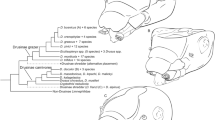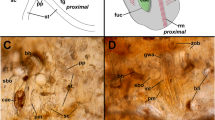Abstract
Rotifers are diverse and abundant aquatic micrometazoans that rely on their ciliated apical end (corona) for locomotion and feeding. In order Collothecaceae, which includes mostly sessile species, larval rotifers go through a complex metamorphosis after settlement wherein they replace their corona with an unusual cup-shaped head that functions exclusively in food capture. This new head, called the infundibulum, consists of morphological elaborations such as lobes or tentacles that develop precociously in the larval stage; in adults they function in ambush and sit-and-wait predation. Here, we provide evidence from brightfield and transmission electron microscopy that the infundibulum of collothecid rotifers is derived from the larval foregut and not the larval corona, suggesting that the adult head of collothecids is a morphological novelty and therefore not homologous with the rotifer corona as classically defined. The wide variety of morphologies of the infundibulum suggests that selection to maximize foraging may have driven the evolution of head form in these sessile species, and that future studies of collothecid rotifers should consider the infundibulum as a unique form of food-collection device that is evolutionarily distinct from the rotifer corona.







Similar content being viewed by others
References
Bevington, D. J., C. White & R. L. Wallace, 1995. Predatory behavior of Cupelopagis vorax (Rotifera; Collothecaceae; Atrochidae) on protozoan prey. Hydrobiologia 313(314): 213–217.
Boschetti, C., C. Ricci, C. Sotgia & U. Fascio, 2005. The development of a bdelloid egg: a contribution after 100 years. Hydrobiologia 546: 323–331.
Brigandt, I., 2003. Homology in comparative, molecular, and evolutionary developmental biology: the radiation of a concept. Journal of Experimental Zoology 299B: 9–17.
Champ, P., 1978. Dyanmique d’une population d’un Rotifère épiphyte thermophile (Sinantherina socialis) en présence de pollution thermique. Archiv für Hydrobiologie 82(2): 213–223.
Clément, P. & E. Wurdak, 1991. Rotifera. In Harrison, F. W. & E. E. Ruppert (eds), Microscopic Anatomy of Invertebrates, Vol. 4., Aschelminthes Wiley-Liss Inc, New York: 219–297.
Cubitt, C., 1869. Floscularia coronetta, a new species; with observations on some points in the economy of the genus. Monthly Microscopical Journal 133–140: 24–25.
Cubitt, C., 1870. Observations on some points in the Economy of Stephanoceros. The Monthly Microscopical Journal 3(5): 240–249.
de Beauchamp, P., 1907. Morphologie et variations de l’appareil rotateur dans la serie des rotifères. Archives de Zoologie Experimentale (ser. 4) 6: 1–29.
de Beauchamp, P., 1965. Classe des Rotifères. In Grassé, P. P. (ed.), Traité de Zoologie IV, 3. Masson, Paris: 1225–1379.
Dobie, W. M., 1849. Description of two new species of Floscularia, with remarks. The Annals and Magazine of Natural History (ser. 2) 4: 233–238, pl. 6
Felix, A., M. E. Stevens & R. L. Wallace, 1995. Unpalatability of a colonial rotifer, Sinantherina socialis, to small zooplanktivorous fishes. Invertebrate Biology 114: 139–144.
Fontaneto, D. & W. H. De Smet, 2015. Rotifera. In Schmidt-Rhaesa, A. (ed.), Handbook of Zoology, Gastrotricha, Cycloneuralia and Gnathifera, Vol. 3. Gastrotricha and Gnathifera, Walter De Gruyter GmbH, Berlin: 354.
Fontaneto, D., G. Melone & R. L. Wallace, 2003. Morphology of Floscularia ringens (Rotifera, Monogononta) from egg to adult. Invertebrate Biology 122: 231–240.
Gegenbaur, C., 1859. Grundzüge der vergleichenden Anatomie. Wilhelm Engelmann, Leipzig.
Gosse, P. H., 1862. Contributions to the history of the Rotifera, or wheel animalcules. I. The crown animalcule (Stephanoceros eichhornii). The Popular Science Review, London: 26–49, pl. 3.
Herlyn, H., O. Piskurek, J. Schmitz, U. Ehlers & H. Zischler, 2003. The syndermatan phylogeny and the evolution of acanthocephalan endoparasitism as inferred from 18S rDNA sequences. Molecular Phylogenetics and Evolution 26: 155–164.
Hochberg, A. & R. Hochberg, 2015. Serotonin immunoreactivity in the nervous system of the free-swimming larvae and sessile adult females of Stephanoceros fimbriatus (Rotifera: Gnesiotrocha). Invertebrate Biology 134: 261–270.
Hochberg, A. & R. Hochberg, 2017. Musculature of the sessile rotifer Stephanoceros fimbriatus (Rotifera: Gnesiotrocha: Collothecaceae) with details on larval metamorphosis and development of the infundibulum. Zoologischer Anzeiger 268: 84–95.
Hochberg, R., S. O’Brien & A. Puleo, 2010. Behavior, metamorphosis and muscular organization of the predatory rotifer, Acyclus inquietus (Rotifera, Monogononta). Invertebrate Biology 129: 210–219.
Kellicott, D. S., 1885. A new floscule. Proceedings of the American Society of Microscopists 7: 48.
Kutikova, L. A., 1995. Larval metamorphosis in sessile rotifers. Hydrobiologia 313(314): 133–138.
Linnæus, C., 1758. Systema naturæ per regna tria naturæ, secundum classes, ordines, genera, species, cum characteribus, differentiis, synonymis, locis. Tomus I. Editio decima, reformata. - pp. [1–4], 1–824. Holmiæ. (Salvius).
Mantell, G. A., 1846. Thoughts on Animalcules: or, A Glimpse of the Invisible World Revealed by the Microscope. London: 144.
Meksuwan, P., P. Pholpunthin & H. Segers, 2013. The Collothecidae (Rotifera, Collothecaceae) of Thailand, with the description of a new species and an illustrated key to the Southeast Asian fauna. ZooKeys 315: 1–16.
Meksuwan, P., P. Pholpunthin & H. H. Segers, 2015. Molecular phylogeny confirms Conochilidae as ingroup of Flosculariidae (Rotifera, Gnesiotrocha). Zoologica Scripta 44: 562–573.
Melone, G., 1998. The rotifer corona by SEM. Hydrobiologia 387(388): 131–134.
Melone, G., 2001. Rhinoglena frontalis (Rotifera, Monogononta): a scanning electron microscopic study. Hydrobiologia 446(447): 291–296.
Melone, G. & C. Ricci, 1995. Rotatory apparatus in Bdelloids. Hydrobiologia 313(314): 91–98.
Montgomery, T. H., 1903. On the morphology of the rotatorian family Flosculariidae. Proceedings of the Academy of Natural Science Philadelphia 55: 363–395.
Paez, M. E. C., H. Kurokura & S. Kasahara, 1988. Embryonic development of amictic eggs of a rotifer Brachionus plicatilus. Journal of the Faculty of Applied Biological Science 27: 93–99.
Pray, F. A., 1965. Studies on the early development of the rotifer Monostyla cornuta Muller. Transactions of the American Microscopical Society 84: 210–216.
Remane, A., 1933. Aschelminthes. Rotatoria. In H.G. Bronn’s Klassen und Ordnungen des Tierreichs. Vermes. II. Abteilung: Aschelminthen. I. Buch: Rotatorien, Gastrotrichen und Kinorhynchen 4 (3. und. 4. Lieferung). Akademische Verlagsgesellschaft, Leipzig: 289–576.
Remane, A., 1956. Die Grundlagen des natürlichen Systems, der vergleichenden Anatomie und der Phylogenetik. Theoretische Morphologie und Systematik I, 2nd ed. Geest & K. G. Portig, Leipzig.
Ruppert E. E., 1982. Homology recognition as a basis for comparative biology. In: Proceedings of the third international symposium on the Tardigrada. East Tennessee State University Press, Johnson City: 32–53.
Segers, H., 2007. Annotated checklist of the rotifers (Phylum Rotifera), with notes on nomenclature, taxonomy, and distribution. Zootaxa 1564: 1–104.
Sørensen, M. V., 2002. On the evolution and morphology of the rotiferan trophi, with a cladistic analysis of Rotifera. Journal of Zoological Systematics and Evolutionary Research 40: 129–154.
Sørensen, M. V. & G. Giribet, 2006. A modern approach to rotiferan phylogeny: combining morphological and molecular data. Molecular Phylogenetics and Evolution 40: 585–608.
Surface, F. M., 1906. The formation of new colonies of the rotifer, Megalotrocha alboflavicans, Ehr. Biological Bulletin 11(4): 182–192.
Tannreuther, G. W., 1920. The development of Asplanchna ebbesbornii. Journal of Morphology 33(2): 389–437.
Vasishist, H. S. & B. L. Dawar, 1969. Anatomy and histology of the rotifer Cupelopagis vorax Leidy. Research Bulletin (N.S.) of the Panjab University 20: 207–221.
Wagner, G. P., 1989. The biological homology concept. Annual Reviews in Ecology and Systematics 20: 51–69.
Wallace, R. L. & W. T. Edmonson, 1986. Mechanism and adaptive significance of substrate selection by a sessile rotifer. Ecology 67: 314–323.
Wallace, R. L. & H. A. Smith, 2013. Rotifera. eLS, Wiley, Chichester. https://doi.org/10.1002/9780470015902.a0001588.pub2.
Wallace, R. L., T. W. Snell, C. Ricci, & T. Nogrady, 2006. Rotifera. Volume 1: Biology, Ecology and Systematics (2nd edition). Guides to the Identification of the Microinvertebrates of the Continental Waters of the World, No. 23, ed. H. Segers. Backhuys Publishers: Leiden.
Wallace, R. L., T. Snell & H. A. Smith, 2015. Rotifera: ecology and general biology. In Thorp, J. H & D. C. Rogers (eds), Thorp and Covich’s Freshwater Invertebrates. Elsevier, Waltham, MA: 225–271.
Wilson, E. B., 1896. The embryological criterion of homology. Biological Lectures of MBL Woods Hole 1894: 101–124.
Wright, H. G. S., 1950. A contribution to the study of Floscularia ringens. Journal of the Quekett Microscopical Club Series 4(3): 103–116.
Wright, H. G. S., 1955. Ciliation of Stephanoceros fimbriatus. Quekett Microscopical Club 4(3): 361–366.
Wright, H. G. S., 1958. Capture of food by collothecid Rotatoria. Journal of the Quekett Microscopical Club Series 5(2): 36–40.
Wurdak, E., P. Clément & J. Amsellem, 1983. Sensory receptors involved in the feeding behavior of the rotifer Asplanchna brightwelli. Hydrobiologia 104: 203–212.
Zacharias, O., 1894. Faunistische Mittheilungen. Forschungsberichte aus der Biologischen Station zu Plön 2: 57–90.
Acknowledgements
We would like to thank the editors and anonymous reviewers that provided valuable recommendations to improve this manuscript. This research was supported by the National Science Foundation (NSF) to RH (DEB 1257110), EJW (DEB 1257068), and RLW (DEB 1257116); and the National Institutes on Minority Health and Health Disparities (2G12MD007592), a component of the National Institutes of Health (NIH)]. Any opinions, findings, and conclusions or recommendations expressed in this material are those of the authors and do not necessarily reflect the views of the NSF and NIH.
Author information
Authors and Affiliations
Corresponding author
Additional information
Guest editors: Steven A. J. Declerck, Diego Fontaneto, Rick Hochberg & Terry W. Snell / Crossing Disciplinary Borders in Rotifer Research
Rights and permissions
About this article
Cite this article
Hochberg, R., Yang, H., Hochberg, A. et al. When heads are not homologous: the coronae of larval and adult collothecid rotifers (Rotifera: Monogononta: Collothecaceae). Hydrobiologia 844, 191–207 (2019). https://doi.org/10.1007/s10750-018-3760-3
Received:
Revised:
Accepted:
Published:
Issue Date:
DOI: https://doi.org/10.1007/s10750-018-3760-3




